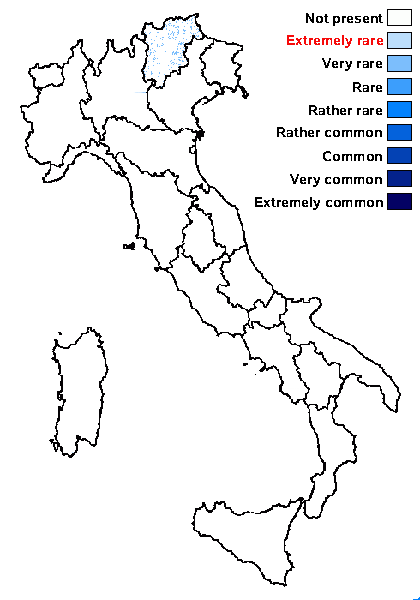Protothelenella anodonta (Nyl.) Hafellner
in Nimis & al., MycoKeys, 31: 10, 2018.. Basionym: Odontotrema anodontum Nyl. - Flora, Regensburg, 52: 411, 1869.
Synonyms: Mycoglaena lichenoides (Rehm ex Sacc.) Riedl; Mycowinteria anodonta (Nyl.) Sherwood & Boise; Trematosphaeria lichenoides Rehm nom. nud.; Winteria lichenoides (Rehm ex Sacc.) Sacc.; Zignoella lichenoides Rehm ex Sacc.
Distribution: N - TAA.
Description: Thallus inapparent, probably not lichenized. Perithecia brown-black, globose to weakly pyriform, up to 0.6 mm across. Exciple greenish black, of strongly anastomosing, conglutinate, to 1 μm thick hyphae with narrow lumina; paraphysoids persistent, thread-like, branched and anastomosing in lower part; periphysoids absent; hymenial gel I+ reddish or I+ blue at low concentrations, K/I+ blue. Asci (4-)8-spored (young asci 8-spored, mature asci often 4-6-spored), cylindrical, short-stalked, thick-walled (2-3 μm), fissitunicate, the outer gelatinous wall layer I+ blue, with a very faintly I+ blue apical plug. Ascospores submuriform, with 3-5 tranverse septa and 1 incomplete longitudinal septum, hyaline, ellipsoid-oblong, 14-18 x 6-8 μm, with a tapering lower end. Photobiont probably absent. Spot tests: K-, C-, KC-, P-. UV-. Chemistry: without lichen substances. Note: a doubtfully lichenised species found on decaying wood of conifers in the subalpine belt; known from Fennoscandia and Central Europe, with a few records from the Eastern Alps (Austria, Italy).
Growth form: Crustose
Substrata: lignum
Photobiont: green algae other than Trentepohlia
Reproductive strategy: mainly sexual
Commonnes-rarity: (info)
Alpine belt: absent
Subalpine belt: very rare
Oromediterranean belt: absent
Montane belt: absent
Submediterranean belt: absent
Padanian area: absent
Humid submediterranean belt: absent
Humid mediterranean belt: absent
Dry mediterranean belt: absent

Predictive model
Growth form: Crustose
Substrata: lignum
Photobiont: green algae other than Trentepohlia
Reproductive strategy: mainly sexual
Commonnes-rarity: (info)
Alpine belt: absent
Subalpine belt: very rare
Oromediterranean belt: absent
Montane belt: absent
Submediterranean belt: absent
Padanian area: absent
Humid submediterranean belt: absent
Humid mediterranean belt: absent
Dry mediterranean belt: absent

Predictive model
 Index Fungorum
Index Fungorum
 GBIF
GBIF

